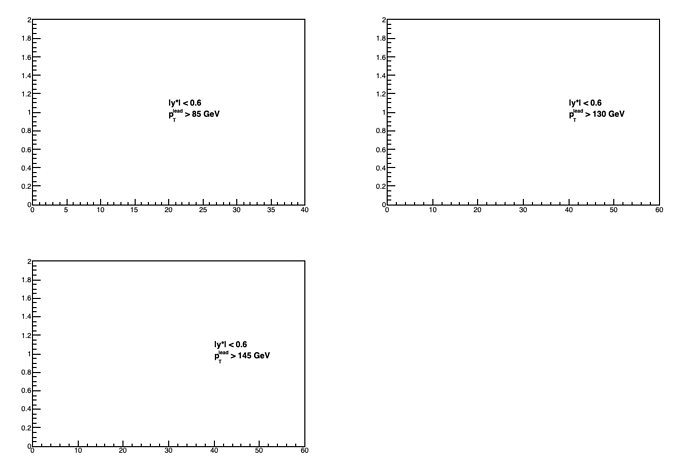Hi all, I am trying to add text to my plot. I have a canvas which is divided into 4, and I am trying to add text to each one of these 4 pads with TLatex. I tried accessing one pad at a time and adding the text, and then move on to the next pad and so on. However, the problem is that all of my text is added on top of each other on the same pad (the 4th pad). Does anyone know what I am doing wrong? Thanks!
#include "TFile.h"
#include "TCanvas.h"
#include "TH1.h"
#include "TMultiGraph.h"
#include "TVectorD.h"
#include "TGraphAsymmErrors.h"
#include "TString.h"
#include <vector>
#include <iostream>
#include "TLatex.h"
void mjj(const char *fname = "HaddOutput.root") {
if (!(fname && fname[0])) return; // just a precaution
TFile *f = TFile::Open(fname);
if ((!f) || f->IsZombie()) { delete f; return; } // just a precaution
std::vector<int> pT1Cut = {85, 130, 145, 220};
std::vector<int> pT2Cut = {60, 70, 85, 90, 100, 110, 120, 130, 145, 150, 160, 170, 185, 190, 200, 210, 220};
int n1 = pT1Cut.size();
int n2 = pT2Cut.size();
TCanvas *c = new TCanvas("c", "", (n1 * 350), 1000);
c->Divide(2, 2)
c->SetFillColor(0);
std::vector<std::vector<double> > offset {
{160,170,190},
{250, 250, 250, 255, 260, 285, 295, 320},
{285, 285, 285, 287, 290, 295, 307, 320, 350},
{450,450,450,450,450,450,450,450,450,450, 450, 460, 480, 480, 490, 500, 520},
};
TH1D *h[n1];
TH1D *k[n1][n2];
TF1 *fit[n1][n2];
TF1 *sigmoid[n1][n2];
TMultiGraph *mg[n1];
TGraphAsymmErrors *eff[n1][n2];
TH1D *histo = (TH1D*)f->Get("AfterCuts/yCut_0.6/pT1Cut_0/pT2Cut_0/Mjj");
std::vector<std::vector<double> > x_value(4, std::vector<double> (17));
for (int i = 0; i < n1; i++) {
c->cd(i + 1);
f->GetObject(TString::Format("AfterCuts/yCut_0.6/pT1Cut_%d/pT2Cut_0/Mjj", pT1Cut[i]), h[i]);
if (!h[i]) continue; // just a precaution
mg[i] = new TMultiGraph();
for (int j = 0; j < n2; j++) {
f->GetObject(TString::Format("AfterCuts/yCut_0.6/pT1Cut_%d/pT2Cut_%d/Mjj", pT1Cut[i], pT2Cut[j]), k[i][j]);
if (!k[i][j]) continue; // just a precaution
if (pT2Cut[j] > pT1Cut[i]) continue; // skip unwanted
eff[i][j] = new TGraphAsymmErrors();
eff[i][j]->Divide(k[i][j], histo, "n");
for (int m = (eff[i][j]->GetN() - 1); m>=0; m--) {
if (eff[i][j]->GetY()[m] < 0.997) eff[i][j]->RemovePoint(m);
}
mg[i]->Add(eff[i][j], "p");
fit[i][j] = new TF1("sigm_%d", "(1/(1+ TMath::Exp(-[0]*(x-[1]))))", 0, 1500); // Sigmoid fit to efficiency plots
fit[i][j]->SetParameters(0.28, offset[i][j]);
fit[i][j]->SetLineColor(kGray);
eff[i][j]->Fit("sigm_%d", "EX0");
sigmoid[i][j] = eff[i][j]->GetFunction(fit[i][j]->GetName()); // Find turn-on
x_value[i][j] = sigmoid[i][j]->GetX(0.999, x_min[i][j], x_max[i][j]);
}
mg[i]->GetYaxis()->SetTitle("Efficiency");
mg[i]->GetXaxis()->SetTitle("M_{jj} (GeV)");
mg[i]->GetXaxis()->SetLimits(0, 1500);
mg[i]->Draw("AL");
}
c->cd(0);
c->cd(1);
TLatex text1(20,0.9996,"#splitline{|y*| < 0.6}{p_{T}^{lead} > 85 GeV}");
text1.SetTextSize(0.04);
text1.DrawClone();
c->cd(2);
TLatex text2(40,0.9996,"#splitline{|y*| < 0.6}{p_{T}^{lead} > 130 GeV}");
text2.SetTextSize(0.04);
text2.DrawClone();
c->cd(3);
TLatex text3(40,0.9996,"#splitline{|y*| < 0.6}{p_{T}^{lead} > 145 GeV}");
text3.SetTextSize(0.04);
text3.DrawClone();
}
